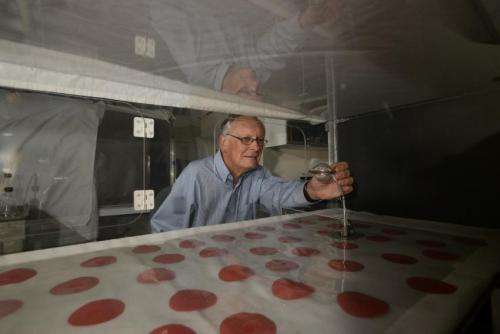How malaria-spreading mosquitoes can tell you're home

Females of the malaria-spreading mosquito tend to obtain their blood meals within human dwellings. Indeed, this mosquito, Anopheles gambiae, spends much of its adult life indoors where it is constantly exposed to human odor - from used clothing, bedding, etc. - even when people are absent.
But is human odor enough as a reliable cue for the mosquitoes in finding humans to bite?
Not quite, reports a team of entomologists at the University of California, Riverside in a research paper published online earlier this month in the Journal of Chemical Ecology. The researchers' experiments with female Anopheles gambiae show that the mosquitoes respond very weakly to human skin odor alone. The researchers found that the mosquitoes' landing on a source of skin odor was dramatically increased when carbon dioxide was also present, even at levels that barely exceed its background level. The researchers suggest, too, was that the mosquitoes use a "sit-and-wait" ambush strategy during which they ignore persistent human odor until a living human is present.
"Responding strongly to human skin odor alone once inside a dwelling where human odor is ubiquitous is a highly inefficient means for the mosquito of locating a feeding site," said Ring Cardé, a distinguished professor of entomology, whose lab conducted the research. "We already know that mosquitoes will readily fly upwind towards human skin odor but landing, the final stage of host location, which typically takes place indoors, does not occur unless a fluctuating concentration of carbon dioxide indicates that a human host is present. It may be that upwind flight towards human odor has more to do with locating a human dwelling, which emits human odor even when its occupants are absent, than locating a feeding site per se."
Cardé explained that mosquitoes, once indoors, conserve their energy by ignoring omnipresent human odor in an unoccupied room. Small increases in carbon dioxide indicate to the mosquitoes the probable presence of a human. This then triggers the mosquitoes to land on human skin.
The findings could help in the design on new types of mosquito control. One take-home message from this work is that studies defining which human odors mediate host finding and which compounds are good repellents need to precisely control exposure to above ambient carbon dioxide - an experimenter entering an assay room quickly elevates the level of carbon dioxide and thereby alters the mosquitoes' behavior.
The research shows that when it comes to feeding on humans indoors, malaria mosquitoes have developed a striking adaptation to how carbon dioxide affects their landing on human targets in response to skin odor.
"It also would be useful next to see if mosquitoes' response to skin odor is similarly affected by carbon dioxide in outdoor situations and how these interactions play out in human dwellings," Cardé said.
Larvae of Anopheles gambiae can breed in diverse habitats. This mosquito has evolved to search in human dwellings for blood meals to carry out egg production. The mosquito enters houses throughout the night, peaking around midnight and continuing at a high rate until the early morning hours. Following a blood meal, the mosquito often remains in dwellings until it is ready to lay eggs. Mosquitoes also seek refuge inside human dwellings during the day, taking shelter from high daytime temperatures outside.
Cardé, who occupies the A. M. Boyce Chair in the Department of Entomology, was joined in the study by Ben Webster (first author of the research paper) and Emerson S. Lacey.
To conduct their experiments, the researchers used Anopheles gambiae originating from mosquitoes collected in Cameroon. They collected skin odor by using pieces of white polyester gauze worn by Webster in a cotton sock for 4-6 hours before the experiments began. The landing behavior of the mosquitoes in the experiments was recorded with a video camera equipped with night vision.
Provided by University of California - Riverside


















